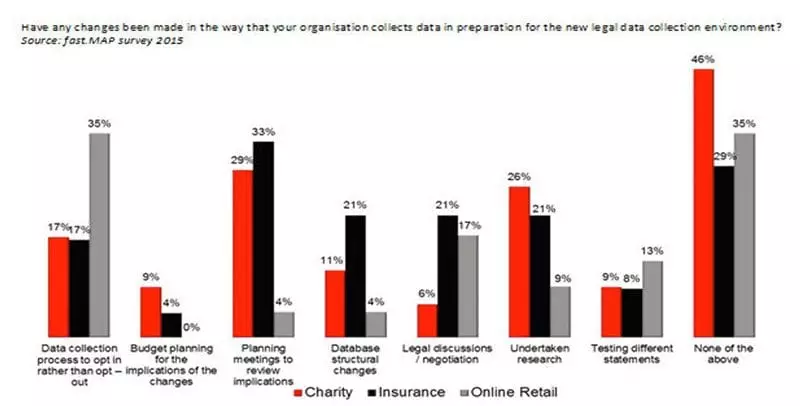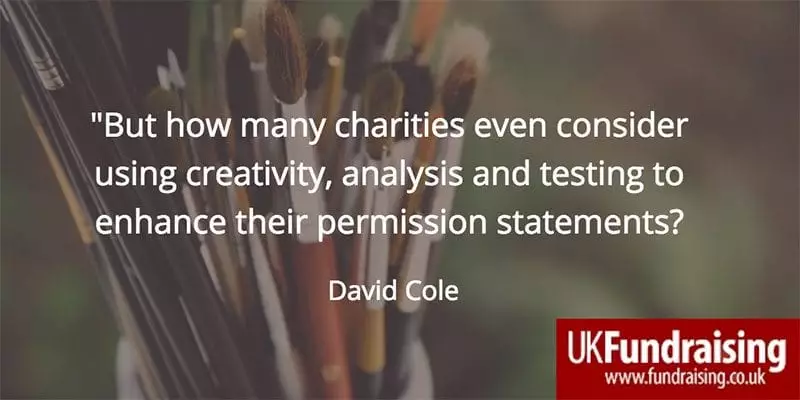No permission: no fundraising contact. Prioritise!
Perfecting permission statements to maximise consent levels may not be as exciting as creating promotions and campaigns, but unless fundraisers focus all their skills and creativity on the task they will be missing what may be their biggest opportunity to maximise donations.
No permission; no fundraising contact.
But consent generation tends to get missed off annual task lists, which means it also misses out on budget and most (69% – source fast.MAP 2015 Data Elephant post-event surveys) of senior marketers do not even measure consent rate, let alone expend effort to improve it.
If fundraisers would only realise that motivational permission statements are potentially more crucial to fundraising than that year’s most financially-important marketing campaign, they might view them differently, because the number of consents gathered will affect every campaign the charity undertakes for years to come.
If the creation of a new permission statement was viewed in the same way as the year’s most crucial fundraising campaign, the creative team and marketing director would be tackling it with passion and dedication. Analysts and the CEO would get involved and creative effort, expertise, analysis and testing would be built into the budget – because if it didn’t work, the consequences would be disastrous.
But how many charities even consider using creativity, analysis and testing to enhance their permission statements? Most regard it as a ‘legal chore’ and few have even bothered to change it since it was created – which probably was many years ago. And it’s most likely to be a single message meant to encompass every type of customer and prospect.
The creative team probably doesn’t regard the permission statement as its concern and the directors are usually only interested in legal compliance. Until recent ethical and legal influences put consent-gathering methods in the spotlight, some charities even chose to discretely hide the opt-out statement to make it more difficult for people to refuse consent.
But devious practices and slipshod statements can have harsh implications. Every day, brands lose money because the considerable talent of their marketing team is not applied to every year’s most crucial marketing project – maximising consent-to- contact.
fast.MAP has tested hundreds of permission statements and knows small differences in wording matter greatly and – once the wording has been decided upon, it needs to be presented creatively.
Consent is a marketing challenge, as is the most effective and engaging way of communicating it – which images; whether to emphasise security or benefits; should control or trust be emphasised?
Consumers are now super-sceptical. In the hide-and-seek-the-opt-in era a small font-size was good. Now it has the reverse effect. People are far more likely to seek out and carefully investigate the permission statement to discover what they are committing to – and small type plants the suspicion the organisation has something to hide.
But it’s very difficult to improve something which isn’t quantified. So the first step is to calculate your charity’s Incremental Preference Value (IPV) to identify the value of each consent over time (this is the digital-age equivalent of Lifetime Value (LTV) that calculates the value of each customer over time).
fast.MAP has created a free IPV calculator to simplify this process.
The next step is to test the effect individual changes to the permission statement(s) have on the IPV.
The sheer number of statement permutations might seem daunting, but not if a test matrix is applied to a benchmarked research process. This will also allow brands to objectively compare the performance of their own statements with those of other charities.
A multi-phased research process drives a ‘test and learn’ approach to deliver insights at each phase and highlight necessary improvements in the next.
Permission statement testing is not like regular marketing-campaign testing, because marketers are obligated to take account of the individual’s latest response. This makes it impractical to trial multiple permission statements in a live environment because it leaves an untidy legacy of the conflicting consumer commitments created by the process.
To remove at least some of this inertia fast. MAP has developed Consent Optimising Benchmarks to allow a brand to test and learn without compromising its own precious database.
You can find out more about enhancing your permission statement in fast.MAP’s ‘Guide to Creating Charity Permission Statements’ – normally £50 but free for UK Fundraising readers who use the following download code: COGCH0316.
Advertisement





